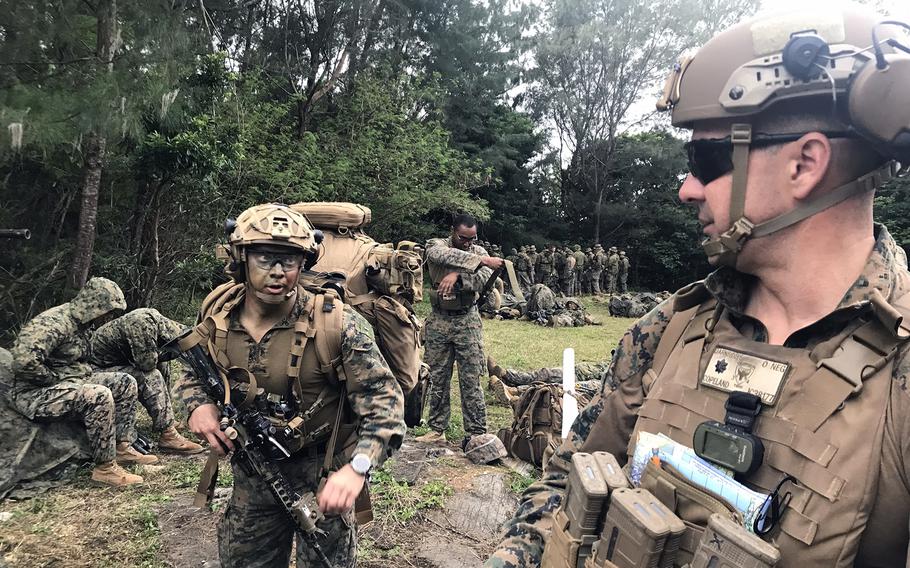
Lt. Col. Jason Copeland, right, commander of 3rd Battalion, 4th Marine Regiment, prepares to board a CH-53 Super Stallion at Camp Schwab, Okinawa, Feb. 14, 2023. (Matthew M. Burke/Stars and Stripes)
CAMP SCHWAB, Okinawa — The Marine Corps took on fellow Marines and Army Special Forces during a recent jungle warfare exercise to hone a key piece of the Marine commandant’s island-fighting doctrine for the Pacific.
About 600 members of 3rd Battalion, 4th Marines and 1st Battalion, 7th Marines took positions in Okinawa training areas starting Feb. 13 for the third annual Jungle Warfare Exercise, said Maj. Charlie Richardson, future operations officer for the 4th Marine Regiment. They stayed in the field until Friday, when the exercise concluded.
The Marines — with support from the Navy, Air Force and Army — were evaluated on how they maintained multiple communication channels, resupplied and sustained themselves in an austere environment, purified their water and cared for their casualties.
"With each of these exercises, we’re taking a facet of stand-in-force, [expeditionary advanced base operations] concepts, and we’re able to put that to the test," Richardson said Tuesday.
The stand-in force is a key tenet of Marine Corps Commandant Gen. David Berger’s 3 ½-year-old service-wide redesign called Force Design 2030. It calls for inserting smaller, mobile units within range of enemy missiles to seize and hold key islands and deny enemy vessels access to the surrounding seas.
Richardson would not say that the adversary in this scenario is China, but the communist nation is identified as a threat in the 2022 National Defense Strategy.
Command and control
Tuesday morning, about 200 Marines from 3rd Battalion queued at Camp Schwab's Landing Zone Phoenix. They clambered in waves aboard CH-53 Super Stallion helicopters, some carrying portable Stinger and Javelin anti-tank missiles, others with Carl-Gustaf recoilless rifles.
The Super Stallions dropped the Marines onto the Northern Training Area, an 18,000-acre swath surrounding the service’s Jungle Warfare Training Center, also known as Camp Gonsalves in Higashi.
Their job was to disperse, occupy defensive positions, link up with a friendly force and prepare to contest the amphibious landing by other Marines and soldiers from 1st Battalion, 1st Special Forces Group out of Torii Station, Richardson said.
Portable generators and communications gear, both voice and data, filled the back of small, two-person utility vehicles. The all-terrain vehicles were loaded onto the helicopters for insertion as well.
Redundant communications systems allowed the battalion commander, Lt. Col. Jason Copeland, to oversee the action from a forward command-and-control node, a vehicle or a rear command post.
“So there’s a lot of different places where the same information is being passed and wherever the commander is,” Copeland said as he waited to board. “Here, you have to be able to communicate on multiple different waveforms because the adversary can challenge any of those waveforms.”
Forward mindset
Elements of the battalion on Wednesday and Thursday participated in live-fire training at the Whiskey 174 Joint Okinawa Training Range Complex, an uninhabited island off the coast, 3rd Marine Division spokesman Lt. Col. Kurt Stahl said Thursday.
They were backed by mortars and close air support. Strikes from the Marine M142 High Mobility Artillery Rocket System, or HIMARS, jets and ships were simulated.
Around noon Tuesday, a C-130 from the Air Force’s 353rd Special Operations Wing landed approximately 50 Marines from the regimental headquarters on the Kadena Air Base flight line.
They quickly moved to an empty building and set up yet another command post.
“I think it's important for each unit to stretch its logistical footprint and try and stay in that forward mindset," Sgt. Kyran Brobst, 22, of Allentown, Pa., said of the exercise. "Obviously sets and reps make a difference, especially when you're training to fight an enemy that's very well equipped."